Trip Report - 5-29-16
Simplifying Flies III
Minimal Dace Prototypes
For the TenkaraBum Streamer Challenge I tied some simple bucktails. Many species of small fish have similar coloration - brown back, black line down the side, and white belly. Art Flick's Blacknose Dace is the best known fly with that color pattern, tied to imitate the blacknose dace common in his home waters in the Catskills. Flick tied the fly with brown bucktail over black bear hair over polar bear hair. The hook shank was covered with silver tinsel and the fly had a short tail of red wool.
If you are not a very skilled tyer, getting three colors of hair to stay in discreet layers is well nigh impossible. Plus, even if you are a skilled tyer, getting some legal polar bear hair is well nigh impossible.
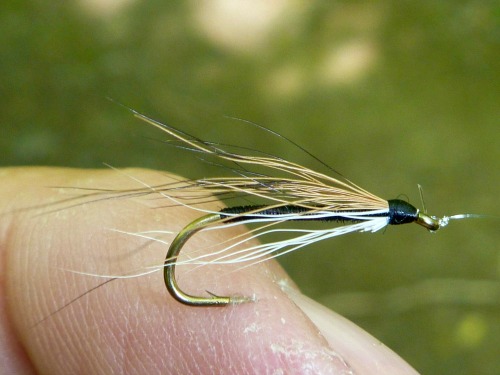
I thought
a blacknose dace imitation would be much simpler if the black stripe was
represented by black thread wound on the hook shank. The brown back of the
blacknose dace could still be the brown hair on the back of an easily-sourced
bucktail, and the white belly could be white hair from the bucktail, tied in as a throat. Thus, a bucktail and a spool of black thread would be the only materials needed.
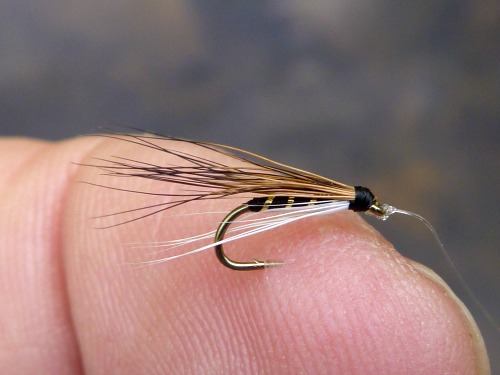
I tried several variations on the same theme, some tied a bit fuller, some sparser, some with gold mylar ribbing. All worked, so I think in the future I will forego the ribbing and keep the white throat/belly pretty sparse. It seems only a few white hairs are necessary to give the impression of a minnow or dace - and to let you see the fly in quiet water. Before taking the first photo above I cut back the number of white hairs after seeing how white one of my other bucktails looked in the water.
Unfortunately, I ran into a problem shared by a few of the people who wrote in asking if their flies would be acceptable entries in the TenkaraBum Streamer Challenge - I didn't have any streamer hooks.
A streamer or bucktail is an elongated fly that represents a baitfish. You can achieve the elongation with a long-shanked hook or with a shorter hook and a very long wing. If the hook is short, the wing has to be disproportionately long. Otherwise the fly looks like a wet fly rather than streamer or bucktail.
Some of the flies I tied, hoping for bucktail proportions, came out looking like wet flies instead. On Sunday I used the ones with the longer wings relative to the hook size.
I am going to get some longer hooks to try. The 1XL Daiichi 1560 seemed just a bit too short. I'll try some 2XL and 3XL hooks to see how they look. I think I'll also get some size 18 Aberdeen hooks, hoping they won't be too big for micros. 4XL hooks are clearly steamer hooks, but they don't come as small as I want.
I'm not entirely sure the small hooks will be necessary, or even useful, though. I caught a couple small creek chubs that easily took a size 12 hook. The smaller micros I saw showed no interest in a bucktail tied on a size 20.
Despite the lack of interest from any micros other than the creek chubs, it was a very productive day. Coach and I started the day on a stream that is reliable for brown trout and fallfish, and where we have also caught common shiners, blacknose dace and one white sucker. The water was low and clear, and the sky was high and clear. It would be a shadow management day.
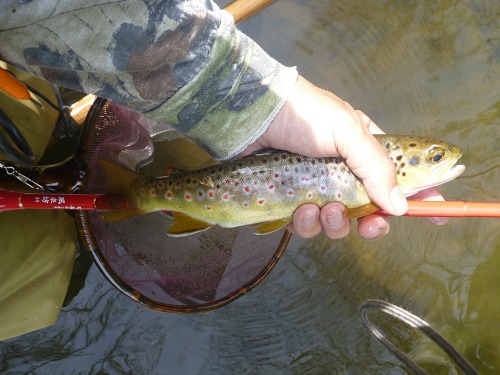
Coach caught a fallfish pretty quickly and I had a brown trout soon thereafter. At 10", it was larger than I expected from the skinny water where I'd caught it, and it hit the bucktail harder than I'd expected (like I said, I haven't fished streamers much). After a while, coach caught his brown trout, achieving his goal for that stream. I never did catch a fallfish. I did catch two more bowns, and like the first, they just slammed the bucktail.
The second one was instructive. I have often found that trout hold in quiet water just below a riffle, and it doesn't have to be a very big riffle, either. There was one spot that had always looked "fishy" but where I had never gotten a hit. It was small enough and well enough protected that it was very hard to get a fly to just the right spot to get a good drift.
Fishing the bucktail from directly upstream, letting it drift down the riffle into the quiet water and then just holding it there, letting it shift to the right and left a bit by moving the rod tip produced a slashing strike. Like my first one of the day, the trout hooked itself on the take.
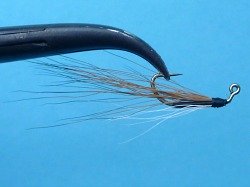
I tried that same technique on the next stream we went to, which was considerably smaller, and just kept getting caught on rocks when I tightened the line to move the bucktail.
In retrospect, I think the solution, particularly on a shallower stream, is to use the Daiichi 4640 hook, which is a 60 degree jig
hook. Tie the bucktail "upside down" like a Clouser, with the white belly on top of the shank and the brown back underneath. If you tie the white belly very sparsely, with only a few hairs, the
bucktail will reliably swim with the hook point up even without tying in eyes.
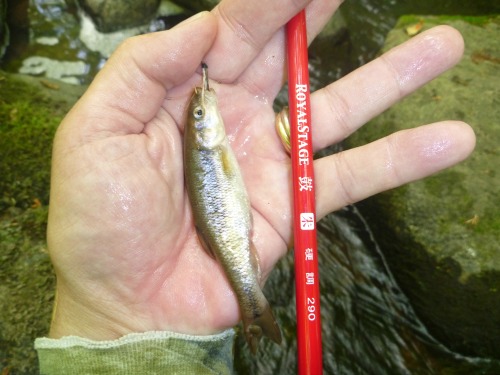
The second stream is one where we usually catch brook trout and creek chubs, and where we have also caught blacknose dace. Our goal was the brookie and the chub. Coach again achieved his goal and I again caught only one of the two target fish. I managed to catch two creek chubs but blanked on the brookie.
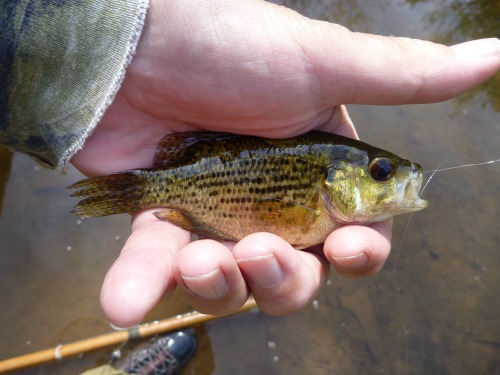
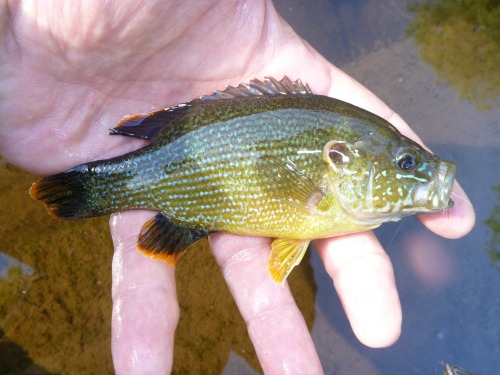
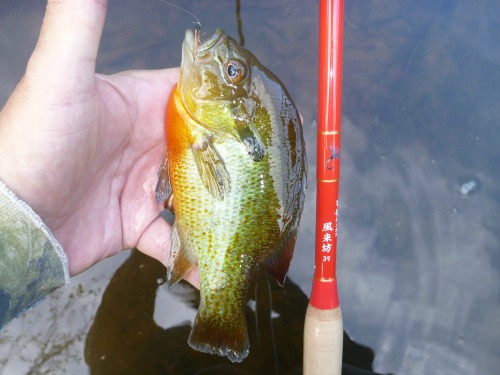
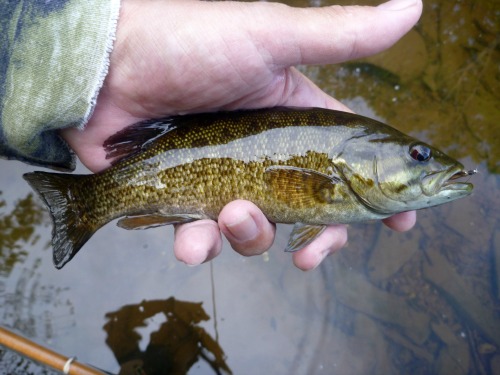
Our third spot was a warm water stream where we have caught a wide variety of species in the past. My target fish were green sunfish and rock bass, as I don't have any other convenient spots to catch them. This time I exceeded my goal, catching a couple green sunfish and more rock bass than I'd ever seen there before. I also caught redbreast sunfish and smallmouth bass. Coach caught the same four species, but for some reason did not take a photo of the smallie. He wants that fish for the Challenge so he'll have to go back.
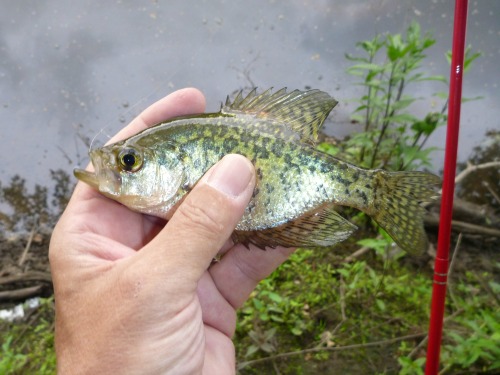
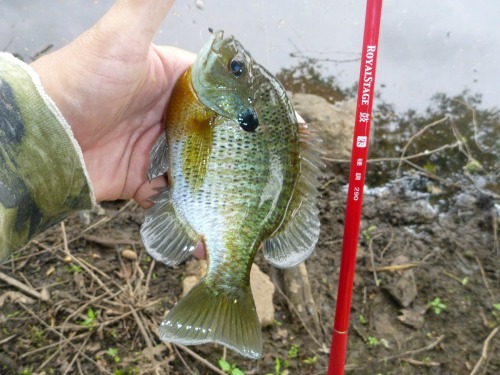
We had time for one more very brief stop before my train came. Coach took me to a spot where he said I could catch black crappie and bluegill sunfish. He had caught both of those species plus redbreast sunfish there early that morning before meeting my train. Sure enough, they were right where he said they would be, and I pretty quickly was able to add black crappie and bluegill sunfish to the day's tally.
I ended up with eight species for the day, which is fewer than our best day, but still isn't bad. It will get harder from here on in.
There is a common saying among fishermen that you should not leave fish to find fish. If you are in a species contest, though, you absolutely do leave fish to find fish, as long as they're different fish!
TenkaraBum > Trip Reports > Trip Report 5-29-16
“The bitterness of poor quality remains long after the sweetness of low price is forgotten” - Benjamin Franklin
"Be sure in casting, that your fly fall first into the water, for if the line fall first, it scares or frightens the fish..." -
Col. Robert Venables 1662
As age slows my pace, I will become more like the heron.
We've all had situations where seriously chewed up flies kept catching fish after fish after fish. It is no sin to tie flies that come off the vise looking seriously chewed up.
Warning:
The hooks are sharp.
The coffee's hot.
The fish are slippery when wet.
Beware of the Dogma
Seriously, all the hooks sold on TenkaraBum.com, whether packaged as loose hooks or incorporated into flies, are dangerously sharp. Some have barbs, which make removal from skin, eyes or clothing difficult. Wear eye protection. Wear a broad-brimmed hat. If you fish with or around children, bend down all hook barbs and make sure the children wear eye protection and broad-brimmed hats. Be aware of your back cast so no one gets hooked.
Also, all the rods sold on TenkaraBum.com will conduct electricity. Do not, under any circumstances, fish during a thunder storm. Consider any fishing rod to be a lightning rod! Fishing rods can and do get hit by lightning!
What's in stock?
Suntech Tenkarakyo 40F Tenkara Rods
Nissin Oni Tenkara Line
Coming Soon
January
Kurenai II AR 30F
Kurenai II AR 33F
Kurenai II AR 39F
TenkaraBum 33
TenkaraBum 36
TenkaraBum 40
Furaibo TF39
Furaibo TF39TA
Latest Pages
If you enjoy spin fishing or baitcasting please visit my sister site Finesse-Fishing.com.


